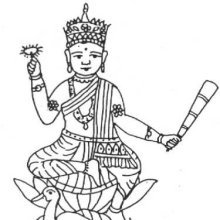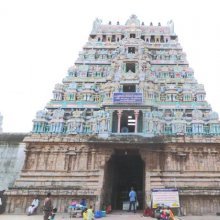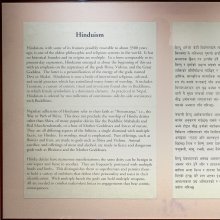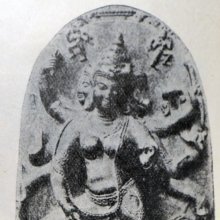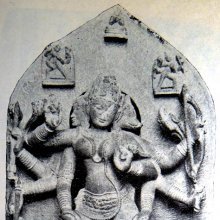Santa, Shanta, Śānta, Santā, Śāntā, Samta, Shamta: 40 definitions
Introduction:
Santa means something in Buddhism, Pali, Hinduism, Sanskrit, Jainism, Prakrit, the history of ancient India, Marathi, biology. If you want to know the exact meaning, history, etymology or English translation of this term then check out the descriptions on this page. Add your comment or reference to a book if you want to contribute to this summary article.
The Sanskrit terms Śānta and Śāntā can be transliterated into English as Santa or Shanta, using the IAST transliteration scheme (?).
Images (photo gallery)
(+2 more images available)
In Hinduism
Natyashastra (theatrics and dramaturgy)
Source: archive.org: The mirror of gesture (abhinaya-darpana)A type of glance (or facial expression): Śānta (peace): gradually closing the lids, the eyes slightly moving, the pupils moving to the comers; the peaceful glance of dispassion.
Source: Shodhganga: Mankhaka a sanskrit literary genius (natya)Śānta (शान्त) or the “sentiment (rasa) of tranquility”.—Viśvanātha Kavirāja is of the opinion that sama (tranquility), which is a mental state of a person, who is free from all attachment and thereby experiences bliss, gives rise to the sentiment called the Śānta (quietistic). It belongs to the very best of men. Its beauty is as fair as Jasmine and the moon and the adorable Nārāyaṇa is its presiding deity. The knowledge of the transitoriness of the world or the knowledge of the Supreme Self becomes the ālambanavibhāvava of this sentiment, whereas, the hermitage, the sporting ground of the Lord and the company of the saints, serve as the uddīpanavibhāvas of the Śāntarasa. Horripilation and the like are itsanubhāvas and indifference, delight, remembrance, intellect and compassion are its vyabhicāribhāvas.
It may be mentioned here that Bharata states that a description, wherein, there is described the state of having no sorrow, no envy, no jealousy and there exists equilibrium of mind, comes as an illustration of the Śāntarasa. Mammaṭa also opines regarding Śānta, that nirveda or complete indifference towards worldly objects, generates the quietistic sentiment.
Source: Shodhganga: Elements of Art and Architecture in the Trtiyakhanda of the Visnudharmottarapurana (natya)1) Śānta (शान्त) refers to the “quiet sentiment” and represents one of the nine kinds of Rasa (“soul of Drama”), according to the Viṣṇudharmottarapurāṇa, an ancient Sanskrit text which (being encyclopedic in nature) deals with a variety of cultural topics such as arts, architecture, music, grammar and astronomy.—Śama is the sthāyibhāva of śānta-rasa. According to the Viṣṇudharmottarapurāṇa, the colour of śānta-rasa is recognized as svabhāvavarṇa i.e., natural colour. Paraḥ purūṣa is regarded as the god of this sentiment. But according to the Sāhityadarpaṇa, Śrīnārāyaṇa is the god of this sentiment.
2) Śāntā (शान्ता) refers to one of the Thirty six kinds of Glances (dṛṣṭi) or “proper accomplishment of glances” (in Indian Dramas).—Dṛṣṭi is very important in a dance form. The appropriate movements of eyes, eyeballs and eyebrows of an artist make the performance more charming. There are thirty six kinds of glances (dṛṣṭi) accepted in the Viṣṇudharmottarapurāṇa, for example śāntā, belonging to the rasadṛṣṭi division.

Natyashastra (नाट्यशास्त्र, nāṭyaśāstra) refers to both the ancient Indian tradition (shastra) of performing arts, (natya—theatrics, drama, dance, music), as well as the name of a Sanskrit work dealing with these subjects. It also teaches the rules for composing Dramatic plays (nataka), construction and performance of Theater, and Poetic works (kavya).
Shaivism (Shaiva philosophy)
Source: Wisdom Library: Kubjikāmata-tantraŚāntā (शान्ता, “Appeased”):—Third of the eight Mātṛs born from the body of Sukṛtālayā, according to the Kubjikāmata-tantra. These eight sub-manifestations (mātṛ) are associated with the (element) water. Śāntā is possibly the name for a river. They are presided over by the Bhairava Kapālīśa and his consort named Cāmuṇḍā. Sukṛtālayā is the Last of the Eight Mahāmātṛs, residing within the Mātṛcakra (third of the five cakras) and represents water.
Source: Shodhganga: Iconographical representations of ŚivaSanta (सन्त) or Santāgama refers to one of the upāgamas (supplementary scriptures) of the Yogajāgama which is one of the twenty-eight Siddhāntāgama: a classification of the Śaiva division of Śaivāgamas. The Śaivāgamas represent the wisdom that has come down from lord Śiva, received by Pārvatī and accepted by Viṣṇu. The purpose of revealing upāgamas (e.g., Santa-āgama) is to explain more elaborately than that of mūlāgamas (e.g., Yogaja-āgama) and to include any new idea if not dealt in mūlāgamas.
Source: Brill: Śaivism and the Tantric TraditionsŚānta (शान्त) refers to “(one who is) peaceful”, according to the Kiraṇatantra chapter 49 (dealing with vratacaryā).—Accordingly, “Garuḍa spoke: ‘You have taught me, O great Lord, the activities of the Neophyte, the Putraka and the Ācārya. Tell me those of the Sādhaka’. The Lord spoke: ‘[...] This is the auspicious Raudra-vrata: imposing with a chignon of matted locks, marked by a trident and khaṭvāṅga, equipped with a clean half skull, awe-inspiring with a third eye, clothed in the skin of a tiger, peaceful (śānta). For one firm [in this observance], the highest siddhi will arise in six months; middling [powers] in four months; the lowest [powers] will arise in three months. [...]’”.
Source: SOAS University of London: Protective Rites in the Netra TantraŚānta (शान्त) refers to “tranquility”, according to the Netratantra of Kṣemarāja: a Śaiva text from the 9th century in which Śiva (Bhairava) teaches Pārvatī topics such as metaphysics, cosmology, and soteriology.—Accordingly, [verse 22.5-10ab]—“Listen! I will speak to the question that remains in your heart. All the innumerable Mantras, on all occasions, have the majesty of Śiva and Śakti, all are endowed with Śakti, all grant rewards and liberation, and [all] are nourished by one’s own Śakti. However, the highest Deva is tranquil (śānta—kintu devaḥ paraḥ śānto), in possession of imperceptible guṇas, [namely] Śiva who consists of all, who is pure, and who is to be understood as unsurpassed. [...]

Shaiva (शैव, śaiva) or Shaivism (śaivism) represents a tradition of Hinduism worshiping Shiva as the supreme being. Closely related to Shaktism, Shaiva literature includes a range of scriptures, including Tantras, while the root of this tradition may be traced back to the ancient Vedas.
Purana and Itihasa (epic history)
Source: archive.org: Puranic Encyclopedia1) Santa (सन्त).—Son of Satya who was born of the family of King Vītahavya. He had a son called Śravas. (Mahābhārata Anuśāsana Parva, Chapter 30, Verse 62).
2) Śānta (शान्त).—Son of Āpa, one of the eight Vasus. He had four sons called Vaitaṇḍa, Śrama, Śānta and Dhvani.
2) In Verse 18, Chapter 66 of Ādi Parva, it is stated that this Śānta was the son of Ahar, the Aṣṭavasu, and that he had three brothers called Śama, Jyotis and Muni.
3) Śānta (शान्त).—A King, the son of Priyavrata. (Bhāgavata, 5th Skandha).
4) Śāntā (शान्ता).—Daughter of Daśaratha. She was brought up by King Lomapāda of Aṅga and was married by muni Ṛṣyaśṛṅga. (For details see Para 9, under Daśaratha).
Source: Cologne Digital Sanskrit Dictionaries: The Purana Index1a) Śānta (शान्त).—One of the seven divisions of Plakṣadvīpa.*
- * Bhāgavata-purāṇa V. 20. 3.
1b) A son of Āyu.*
- * Brahmāṇḍa-purāṇa III. 3. 24.
1c) A sage: His son went on a pilgrimage on his way to Sāligrāma, he wished to see Gandhamādana, Badarikāśrama and others: got frightened by a Gandharva in the form of a tiger which was killed by Paraśurāma. Him followed the sage.*
- * Brahmāṇḍa-purāṇa III. 25. 66-77
1d) A son of Āpa.*
- * Matsya-purāṇa 5. 22; Vāyu-purāṇa 23. 84; 66. 23; Viṣṇu-purāṇa I. 15. 111.
2a) Śāntā (शान्ता).—A daughter of Daśaratha, and adopted by Citraratha-Romapāda: married by Rṣyaśṛṇga, (a daughter of Daśaratha-Lomapāda, Matsya-purāṇa).*
- * Bhāgavata-purāṇa IX. 23. 8; Matsya-purāṇa 48. 95; Viṣṇu-purāṇa IV. 18. 18.
2b) A river in the Kuru country.*
- * Brahmāṇḍa-purāṇa II. 18. 73.
2c) A daughter of Lomapāda.*
- * Vāyu-purāṇa 99. 103.
2d) The mother of the sage Bharadvāja.*
- * Vāyu-purāṇa 111. 60.
Śānta (शान्त) is a name mentioned in the Mahābhārata (cf. I.60.22) and represents one of the many proper names used for people and places. Note: The Mahābhārata (mentioning Śānta) is a Sanskrit epic poem consisting of 100,000 ślokas (metrical verses) and is over 2000 years old.

The Purana (पुराण, purāṇas) refers to Sanskrit literature preserving ancient India’s vast cultural history, including historical legends, religious ceremonies, various arts and sciences. The eighteen mahapuranas total over 400,000 shlokas (metrical couplets) and date to at least several centuries BCE.
Ayurveda (science of life)
Source: gurumukhi.ru: Ayurveda glossary of termsŚānta (शान्त):—[śāntaḥ] Calm disposition; Peaceful

Āyurveda (आयुर्वेद, ayurveda) is a branch of Indian science dealing with medicine, herbalism, taxology, anatomy, surgery, alchemy and related topics. Traditional practice of Āyurveda in ancient India dates back to at least the first millenium BC. Literature is commonly written in Sanskrit using various poetic metres.
Shaktism (Shakta philosophy)
Source: Google Books: ManthanabhairavatantramŚāntā (शान्ता) refers to “she who is tranquil”, representing an aspect of Kālikā, according to the Devīpañcaśataka, an important source of the Kālīkrama that developed in Kashmir after the Kālī Mata of the Jayadrathayāmala.—Accordingly, “The Great God—Mahādeva—is beyond Śakti, supreme bliss, [...] O Supreme Lord! By his awakening, that supreme Kālikā has spontaneously arisen (svecchayā), the one supreme power endowed with those same attributes. She is subtle, supreme, tranquil [i.e., śāntā], and delighted by supreme bliss. Śivā has arisen spontaneously (svabhāvata); stainless, she is (all that is) knowable. She is the Supreme Goddess (parameśvarī) who, by her own will, is (both) the Transmental (unmanā) (‘Without Mind’) and With Mind (samanā)”.

Shakta (शाक्त, śākta) or Shaktism (śāktism) represents a tradition of Hinduism where the Goddess (Devi) is revered and worshipped. Shakta literature includes a range of scriptures, including various Agamas and Tantras, although its roots may be traced back to the Vedas.
Pancaratra (worship of Nārāyaṇa)
Source: University of Vienna: Sudarśana's Worship at the Royal Court According to the AhirbudhnyasaṃhitāŚānta (शान्त) refers to “pacification” (i.e., ‘removing unwanted consequences of ritual mistakes etc.’), according to the Ahirbudhnyasaṃhitā, belonging to the Pāñcarātra tradition which deals with theology, rituals, iconography, narrative mythology and others.—Accordingly, “[This rite] should be employed by utterly glorious Sovereigns when they are in distress—[for this rite] removes the three kinds of sorrow which begin with the one relating to oneself; causes the destruction of all afflictions; is marked by auspiciousness; destroys all enemies; pacifies (śānta) (i.e. removes unwanted consequences of ritual mistakes etc.); is the cause of triumph; kills the Demons; brings about prosperities; subdues all; bestows the longest of lives; is meritorious; [and] was perfomed by ancient Kings”.

Pancaratra (पाञ्चरात्र, pāñcarātra) represents a tradition of Hinduism where Narayana is revered and worshipped. Closeley related to Vaishnavism, the Pancaratra literature includes various Agamas and tantras incorporating many Vaishnava philosophies.
Shilpashastra (iconography)
Source: Shodhganga: Elements of Art and Architecture in the Trtiyakhanda of the Visnudharmottarapurana (shilpa)Śānta (शान्त) or “sentiment of quietism” refers to one of the Nine Sentiments (citrarasa) in ancient Indian Painting (citra), according to the Viṣṇudharmottarapurāṇa, an ancient Sanskrit text which (being encyclopedic in nature) deals with a variety of cultural topics such as arts, architecture, music, grammar and astronomy.—According to the Viṣṇudharmottarapurāṇa nine kinds of sentiments [e.g., śānta—quietism] are reflected through Paintings and these are termed as citrarasas in this work. [...] The śānta-rasa is depicted through the picture of the ascetic people sitting in Yogic posture or meditation. A point to be noted here is that though the delineation of the śānta-rasa is not accepted in Sanskrit drama, drama being all about action, a painter can execute this sentiment very nicely in a Painting as because Painting is a steel medium of expressing the feelings. That is why śānta-rasa is seen to be included in the list of nine citrarasas. If a painter paints a picture of lord Siva in his meditative situation as described in the 3rd canto of the Kumārasambhava, it would definitely reflect the sentiment of peace (śānta).

Shilpashastra (शिल्पशास्त्र, śilpaśāstra) represents the ancient Indian science (shastra) of creative arts (shilpa) such as sculpture, iconography and painting. Closely related to Vastushastra (architecture), they often share the same literature.
General definition (in Hinduism)
Source: WikiPedia: HinduismSantā (संता): Daughter of Dasharatha, Wife of sage Rishyasringa.
In Buddhism
Theravada (major branch of Buddhism)
Source: Pali Kanon: Pali Proper Names1. Santa. Aggasavaka of Atthadassi Buddha. (J.i.39; Bu.xv.19). He was son of the king of Sucandaka, and Upasanta, son of the chaplain, was his friend. These two placed four very learned men at the four gates of the city to inform them of the arrival of any wise men. They announced the arrival of Atthadassi Buddha. Santa and Upasanta visited the Buddha and his monks, gave them meals for seven days, and listened to the Buddhas preaching. On the seventh day they became arahants, with ninety thousand others. BuA. p. 179.
2. Santa. Fifty seven kappas ago there were four kings of this name, previous births of Tissa Thera. ThagA.i.200; but see Ap.i.174, where he is called Bhavanimmita.
3. Santa. A general of Parakkamabahu I. He is called Jitagiri, and was in charge of the Viharavajjasala ford. Cv.lxxv.25.
Santa Sutta. On ten qualities which make a monk altogether charming and complete in every attribute. A.v.11.
Theravāda is a major branch of Buddhism having the the Pali canon (tipitaka) as their canonical literature, which includes the vinaya-pitaka (monastic rules), the sutta-pitaka (Buddhist sermons) and the abhidhamma-pitaka (philosophy and psychology).
Mahayana (major branch of Buddhism)
Source: Wisdom Library: Maha Prajnaparamita SastraŚāntā (शान्ता) is the name of a courtesan according to the 2nd century Mahāprajñāpāramitāśāstra (chapter XXVIII). Accordingly, “there was, at that time in the kingdom of Vārāṇasī, a courtesan named Chan t’o (Śāntā) of unequalled beauty; she came in answer to the king’s appeal. She asked people whether or not [Ekaśṛṇga] was a man; they answered that he was the son of a hermit”.
Source: academia.edu: A Study and Translation of the GaganagañjaparipṛcchāŚānta (शान्त) refers to “peaceful”, according to the Gaganagañjaparipṛcchā: the eighth chapter of the Mahāsaṃnipāta (a collection of Mahāyāna Buddhist Sūtras).—Accordingly, “[...] The Bodhisattva Gaganagañja then sustained the jewel-canopy of ten thousand yojanas high over the Lord’s lion throne in the sky, joined the palms of his hands, saluted, and praised the Lord with these suitable verses: ‘[...] (8) All the dharmas are born from causes and conditions (hetupratyaya). Without any activity or intrinsic nature (asvabhāva), they are generated in thought-constructions (saṃkalpa). But still the Sugata, having known the mode (naya) of such dharmas, obtained the changeless (nirvikāra), peaceful (śānta), unsurpassable (anuttara) awakening. [...]”.

Mahayana (महायान, mahāyāna) is a major branch of Buddhism focusing on the path of a Bodhisattva (spiritual aspirants/ enlightened beings). Extant literature is vast and primarely composed in the Sanskrit language. There are many sūtras of which some of the earliest are the various Prajñāpāramitā sūtras.
Tibetan Buddhism (Vajrayana or tantric Buddhism)
Source: Wisdom Library: Tibetan BuddhismŚānta (शान्त) is the name of a Pratyekabuddha mentioned as attending the teachings in the 6th century Mañjuśrīmūlakalpa: one of the largest Kriyā Tantras devoted to Mañjuśrī (the Bodhisattva of wisdom) representing an encyclopedia of knowledge primarily concerned with ritualistic elements in Buddhism. The teachings in this text originate from Mañjuśrī and were taught to and by Buddha Śākyamuni in the presence of a large audience (including Śānta).
Source: Brill: Śaivism and the Tantric Traditions (tantric Buddhism)Śānta (शान्त) refers to “tranquil” and is used to describe Ādibuddha, according to the Nāmamantrārthāvalokinī by Vilāsavajra, which is a commentary on the Nāmasaṃgīti.—Accordingly, [while describing Ādibuddha]—“[...] He is tranquil (śānta), with the ornaments of a youth, in fine clothing, wearing about himself a many coloured garment. He has eight arms, holding at his heart with four hands the Śatasāhasrikāprajñāpāramitā divided into four parts, [and] carrying, in each of the other four hands, a sword of wisdom in the gesture of striking. [All this is to be] put in place [i.e. visualised] via the yoga of the four Buddha-thrones”.
Source: OSU Press: Cakrasamvara SamadhiŚānta (शान्त) or Śāntatīrtha refers to one of the “eleven holy bathing places” (Puṇyatīrtha), according to the Guru Mandala Worship (maṇḍalārcana) ritual often performed in combination with the Cakrasaṃvara Samādhi, which refers to the primary pūjā and sādhanā practice of Newah Mahāyāna-Vajrayāna Buddhists in Nepal.

Tibetan Buddhism includes schools such as Nyingma, Kadampa, Kagyu and Gelug. Their primary canon of literature is divided in two broad categories: The Kangyur, which consists of Buddha’s words, and the Tengyur, which includes commentaries from various sources. Esotericism and tantra techniques (vajrayāna) are collected indepently.
In Jainism
General definition (in Jainism)
Source: archive.org: The Jaina IconographyŚāntā (शान्ता) (or Śānti, Kālī) is the name of the Yakṣiṇī accompanying Supārśvanātha: the seventh of twenty-four Tīrthaṃkaras or Jinas, commonly depicted in Jaina iconography.—Supārśvanātha has, according to the canon, the emblem of the mystic cross called the Svastika. Books give him the additional symbolic decorations of serpents. There is some regularity with regard to the number of the hoods of the serpents. The number must be either one or five or nine. His Kevala tree is Śirīśa. The attendant spirits serving him are Mātaṅga and Śānti (Digambara: Varanandi and Kālī). The name of the bearer of the fly-fan is Dharmavīrya.
The Śvetāmbara books describe Śāntā as riding an elephant and her hands as furnished with Varada, rosary, lance, and Abhaya. Kālī, her Digambara variant, is known from their literature as being seated on a bull and as carrying in her hands a trident, fruit, Varada and bell. As wife of Yakṣa Mātaṅga literally meaning “elephant”, Śāntā’s syniliolic vehicle of an elephant is evident enough. Her other symbols bespeak her military Yakṣiṇī as well as benign Vidyādevī character. Kālī also takes her place among the Vidyādevīs. Her symbols of a bull, bell, trident make her resemble a Hindu Śaivite goddess on one hand and a citrus makes her unmistakably a Yakṣiṇī on the other.
Source: JAINpedia: JainismŚānta (शान्त, “tranquillity”) refers to one of the “nine sentiments” (navarasa) in poetics and dramaturgy and represents one of the topics dealt with in the Anuyogadvārasūtra : a technical treatise on analytical methods, a kind of guide to applying knowledge.—In Muni Puṇyavijaya’s words, “the Nandi which is of the form of five Jñānas serves as a mangala in the beginning of the study of the Āgamas; and the Anuyogadvāra-sūtra serves as a key to the understanding of the Āgamas”.
Source: The University of Sydney: A study of the Twelve ReflectionsSanta (सन्त) refers to “existing”, according to the 11th century Jñānārṇava, a treatise on Jain Yoga in roughly 2200 Sanskrit verses composed by Śubhacandra.—Accordingly, “Embodied souls, living [com.—santa—‘existing’] in immovable and movable bodies, are born [and] die constrained by the chains of their own actions. In this world sometimes corporeal [souls] filled with a mass of virtue appear in heaven because of the development of life and name karmas connected with the celestial state of existence”.
Synonyms: Saṃcaranta.

Jainism is an Indian religion of Dharma whose doctrine revolves around harmlessness (ahimsa) towards every living being. The two major branches (Digambara and Svetambara) of Jainism stimulate self-control (or, shramana, ‘self-reliance’) and spiritual development through a path of peace for the soul to progess to the ultimate goal.
India history and geography
Source: Cologne Digital Sanskrit Dictionaries: Indian Epigraphical GlossarySanta.—(CITD), Telugu-Kannaḍa; a fair or market day. (EI 14), name of a measure or a coin; probably, a small coin (Ep. Ind., Vol. XV, p. 309). Note: santa is defined in the “Indian epigraphical glossary” as it can be found on ancient inscriptions commonly written in Sanskrit, Prakrit or Dravidian languages.

The history of India traces the identification of countries, villages, towns and other regions of India, as well as mythology, zoology, royal dynasties, rulers, tribes, local festivities and traditions and regional languages. Ancient India enjoyed religious freedom and encourages the path of Dharma, a concept common to Buddhism, Hinduism, and Jainism.
Biology (plants and animals)
Source: Google Books: CRC World Dictionary (Regional names)Santa in India is the name of a plant defined with Vigna unguiculata in various botanical sources. This page contains potential references in Ayurveda, modern medicine, and other folk traditions or local practices It has the synonym Phaseolus cylindricus L. (among others).
Example references for further research on medicinal uses or toxicity (see latin names for full list):
· Über Befruchtungsverhältnisse bei Hülsenfrüchten (1898)
· Catalogus Plantarum in Horto Botanico Bogoriensi Cultarum Alter (1844)
· Flora Lusitanica (1804)
· Mémoires de l’Institut Égyptien (1889)
· Species Plantarum
· Raccolte Botaniche
If you are looking for specific details regarding Santa, for example extract dosage, side effects, health benefits, pregnancy safety, chemical composition, diet and recipes, have a look at these references.

This sections includes definitions from the five kingdoms of living things: Animals, Plants, Fungi, Protists and Monera. It will include both the official binomial nomenclature (scientific names usually in Latin) as well as regional spellings and variants.
Languages of India and abroad
Pali-English dictionary
Source: BuddhaSasana: Concise Pali-English Dictionarysanta : (pp. of sammati) 1. calmed; peaceful; 2. tired; wearied. (adj.), existing. (m.), a virtuous man.
Source: Sutta: The Pali Text Society's Pali-English Dictionary1) Santa, 2 (pp. of sammati2) tired, wearied, exhausted Dh. 60; J. I, 498; Pv. II, 936 (=parissama-patta PvA. 127). (Page 676)
2) Santa, 1 (pp. of sammati1) calmed, tranquil, peaceful, pure D. I, 12; Vin. I, 4; S. I, 5; A. II, 18; Sn. 746; Pv IV. 134 (=upasanta-kilesa PvA. 230); Miln. 232, 409; Vism. 155 (°aṅga; opp. Oḷārik’aṅga); DhA. II, 13; III, 83.—nt. peace, bliss, nibbāna S. IV, 370.

Pali is the language of the Tipiṭaka, which is the sacred canon of Theravāda Buddhism and contains much of the Buddha’s speech. Closeley related to Sanskrit, both languages are used interchangeably between religions.
Marathi-English dictionary
Source: DDSA: The Molesworth Marathi and English Dictionaryśānta (शांत).—f Popular contraction of śānti.
--- OR ---
śānta (शांत).—p (S) Quieted, calmed, composed, appeased, pacified: also quiet, calm, tranquil, serene, not excited or agitated: also mild, gentle, bland, not vehement, impetuous, furious &c.
--- OR ---
santa (संत).—m (S) A holy man, a saint. 2 In the popular acceptation. A religious mendicant who professes great sanctity and piety. santācī jāhagīra mānabhāvācā pyādā (Because neither the santa nor the servant of the mānabhāva is disposed or competent to enforce or insist upon compliance with his alms-begging.) A phrase expressive of exceeding meekness or yieldingness.
--- OR ---
santa (संत).—a Gentle, soft-flowing, calm, unruffled;-- as a stream, a breeze, the water, the air: gently burning;--as a flame: mild, not vehement or violent;--as a disorder or other disturbance: soft, placid, peaceable;--as a disposition or spirit.
--- OR ---
sāṇṭa (सांट).—m f (Better sāṇṭha) Room, capacity, space to contain or hold.
Source: DDSA: The Aryabhusan school dictionary, Marathi-Englishśānta (शांत).—p Quieted, calmed. Mild; quiet.
--- OR ---
śānta (शांत) [-ti, -ति].—f Composing; composure. Stoi- cism; any expiatory rites. Fig. Death.
--- OR ---
santa (संत).—m A holy man, a saint. a Gentle, soft-flowing, calm-as a stream, breeze; gently burning-as a flame; soft, placid-as a disposition.
--- OR ---
sānta (सांत) [-tī, -ती].—f Epidemic disease.
Marathi is an Indo-European language having over 70 million native speakers people in (predominantly) Maharashtra India. Marathi, like many other Indo-Aryan languages, evolved from early forms of Prakrit, which itself is a subset of Sanskrit, one of the most ancient languages of the world.
Sanskrit dictionary
Source: DDSA: The practical Sanskrit-English dictionaryŚānta (शान्त).—p. p. [śam-kta]
1) Appeased, allayed, calmed, satisfied, pacified; चचार सानुजः शान्तो वृद्धेक्ष्वाकुव्रतं युवा (cacāra sānujaḥ śānto vṛddhekṣvākuvrataṃ yuvā) R. 12.2.
2) Cured, alleviated; शान्तरोगः (śāntarogaḥ).
3) Abated, subsided, put an end to, removed, extinguished; शान्त- रथक्षोभपरिश्रमम् (śānta- rathakṣobhapariśramam) R.1.58;5.47; शान्तार्चिषं दीपमिव प्रकाशः (śāntārciṣaṃ dīpamiva prakāśaḥ) Kirātārjunīya 17.16.
4) Ceased, stopped; शान्तमृगप्रचारम् (śāntamṛgapracāram) Kumārasambhava 3.42.
5) Dead, deceased; तेषु सर्वेषु शान्तेषु गतेष्वविदितां गतिम् (teṣu sarveṣu śānteṣu gateṣvaviditāṃ gatim)
6) Stilled, hushed.
7) Calm, quiet, undisturbed, tranquil, still; शान्तमिदमाश्रमपदम् (śāntamidamāśramapadam) Ś.1.16;4.19.
8) Tamed; स्वमाश्रमं शान्तमिदमाश्रमपदम् (svamāśramaṃ śāntamidamāśramapadam) R.14.79.
9) Free from passions, at ease, contented; Bṛ. Up.4.4.23.
1) Shaded.
11) Gentle; शान्तानुकूलपवनश्च शिवश्च पन्थाः (śāntānukūlapavanaśca śivaśca panthāḥ) Ś.4.11;
12) Purified.
13) Meek, humble.
14) Auspicious (in augury); (the phrase śāntaṃ pāpam which is sometimes repeated, means 'oh no!', 'how can it be', 'God forbid such an untoward or unlucky event'; Ś.5; Mu.1).
15) Rendered ineffective, harmless (said of weapons).
-ntaḥ 1 A man who has subdued his passions, an ascetic.
2) Tranquillity, quietism, the sentiment of quietism, the predominant feeling of which is indifference to worldly objects and pleasures; see निर्वेद (nirveda) and रस (rasa).
-ntam Appeasing, pacifying.
-ntam ind. Enough, no more, not so, for shame, hush!, god (heaven) forbid!; शान्तं कथं दुर्जनाः पौरजानपदाः (śāntaṃ kathaṃ durjanāḥ paurajānapadāḥ) Uttararāmacarita 1; तामेव शान्तमथवा किमिहोत्तरेण (tāmeva śāntamathavā kimihottareṇa) 3.26.
--- OR ---
Śāntā (शान्ता).—
1) Name of the daughter of Daśaratha, adopted by the sage Lomapāda and subsequently married by Ṛiṣyaśṛṅga; कन्यां दशरथो राजा शान्तां नाम व्यजीजनत् । अपत्यकृतिकां राज्ञे रोमपादाय यां ददौ (kanyāṃ daśaratho rājā śāntāṃ nāma vyajījanat | apatyakṛtikāṃ rājñe romapādāya yāṃ dadau) || Uttararāmacarita 1.4; see ऋष्यशृङ्ग (ṛṣyaśṛṅga) also.
2) (In music) A particular ऋषि (ṛṣi).
3) A kind of दूर्वा (dūrvā) grass.
Source: Cologne Digital Sanskrit Dictionaries: Edgerton Buddhist Hybrid Sanskrit DictionaryŚānta (शान्त).—(1) perh name of a disciple of Buddha: (in a list) Nīlakeśaṃ ca Vṛddhaṃ ca Śāntaṃ (? or adj. with prec.?) śāstraviśāradaṃ Mahāvastu i.182.19 (verse); (2) one of the (śuddhāvāsakāyika) gods who asked the Buddha to recite the Lalitavistara: Lalitavistara 7.6 (verse); 438.16 (prose, with Praśānta, q.v.; om. in some mss., but Tibetan both, zhi ba daṅ rab tu zhi ba daṅ).
--- OR ---
Santa (सन्त).—= Sanskrit sant, see § 18.5 ff.
Source: Cologne Digital Sanskrit Dictionaries: Shabda-Sagara Sanskrit-English DictionaryŚānta (शान्त).—mfn.
(-ntaḥ-ntā-ntaṃ) 1. Calm, tranquil, pacified. 2. Allayed, alleviated. 3. Meek, humble. 4. Purified, cleansed, freed from, (as soil.) 5. Stilled, hushed, (as wind, &c.) m.
(-ntaḥ) 1. An ascetic, one whose passions are subdued and who is engrossed by meditating on the deity. 2. One of the Rasas or conditions of feeling, delineated in poetry or the drama, tranquillity or tranquil devotion, quietism, the assiduous exercise of meditation, &c. and indifference to all objects of pleasure or pain. n.
(-ntaṃ) Appeasing, pacifying. Ind. (śāntam) A prohibitive particle or interjection, implying negation, avertion, disgust, (fie! for shame! Heaven forbid!) E. śam to be appeased, aff. kta .
--- OR ---
Santa (सन्त).—m.
(-ntaḥ) The hands opened and joined. E. sana bā0 ta .
Source: Cologne Digital Sanskrit Dictionaries: Cappeller Sanskrit-English DictionaryŚānta (शान्त).—[adjective] appeased, still, tranquil, calm, quiet, gentle, meek, soft; extinguished, ceased, dead. [masculine] & [feminine] ā a man’s & woman’s name; [neuter] = seq.
Source: Cologne Digital Sanskrit Dictionaries: Monier-Williams Sanskrit-English Dictionary1) Śanta (शन्त):—a śanti etc. See p. 1055, col. 1.
2) [from śam] b mfn., [Pāṇini 5-2, 138.]
3) Śānta (शान्त):—[from śān] 1. śānta mfn. (perhaps always [wrong reading] for 1. śāta q.v.) = śānita, [cf. Lexicographers, esp. such as amarasiṃha, halāyudha, hemacandra, etc.]
4) [v.s. ...] thin, slender, [Harivaṃśa; Rāmāyaṇa] ([Scholiast or Commentator])
5) 2. śānta mfn. ([from] √1. śam) appeased, pacified, tranquil, calm, free from passions, undisturbed, [Upaniṣad; Mahābhārata] etc.
6) soft, pliant, [Harivaṃśa]
7) gentle, mild, friendly, kind, auspicious (in augury; opp. to dīpta), [Atharva-veda] etc. etc.
8) abated, subsided, ceased, stopped, extinguished, averted (śāntam or dhik śāntam or śāntam pāpam, may evil or sin be averted! may God forfend! Heaven forbid! not so!), [Śatapatha-brāhmaṇa; Mahābhārata; Kāvya literature] etc.
9) rendered ineffective, innoxious, harmless (said of weapons), [Mahābhārata; Rāmāyaṇa]
10) come to an end, gone to rest, deceased, departed, dead, died out, [ib.; Raghuvaṃśa; Rājataraṅgiṇī]
11) purified, cleansed, [Horace H. Wilson]
12) m. an ascetic whose passions are subdued, [Horace H. Wilson]
13) tranquillity, contentment (as one of the Rasas q.v.)
14) Name of a son of Day, [Mahābhārata]
15) of a son of Manu Tāmasa, [Mārkaṇḍeya-purāṇa]
16) of a son of Śambara, [Harivaṃśa]
17) of a son of Idhma-jihva, [Bhāgavata-purāṇa]
18) of a son of Āpa, [Viṣṇu-purāṇa]
19) of a Devaputra, [Lalita-vistara]
20) Śāntā (शान्ता):—[from śānta] f. (in music) a [particular] Śruti, [Saṃgīta-sārasaṃgraha]
21) [v.s. ...] Emblica Officinalis, [cf. Lexicographers, esp. such as amarasiṃha, halāyudha, hemacandra, etc.]
22) [v.s. ...] Prosopis Spicigera and another species, [cf. Lexicographers, esp. such as amarasiṃha, halāyudha, hemacandra, etc.]
23) [v.s. ...] a kind of Dūrvā grass, [cf. Lexicographers, esp. such as amarasiṃha, halāyudha, hemacandra, etc.]
24) [v.s. ...] a [particular] drug (= reṇukā), [cf. Lexicographers, esp. such as amarasiṃha, halāyudha, hemacandra, etc.]
25) [v.s. ...] Name of a daughter of Daśa-ratha (adopted daughter of Loma-pāda or Roma-pāda and wife of Ṛṣya-śṛṅga), [Mahābhārata; Harivaṃśa; Rāmāyaṇa]
26) [v.s. ...] (with Jainas) of a goddess who executes the orders of the 7th Arhat, [cf. Lexicographers, esp. such as amarasiṃha, halāyudha, hemacandra, etc.]
27) [v.s. ...] of a Śakti, [Monier-Williams’ Sanskrit-English Dictionary]
28) Śānta (शान्त):—n. tranquillity, peace of mind, [Bhāgavata-purāṇa]
29) Name of a Varṣa in Jambu-dvīpa, [ib.]
30) Name of a Tīrtha, [Horace H. Wilson]
31) Santa (सन्त):—m. = saṃha-tala, [cf. Lexicographers, esp. such as amarasiṃha, halāyudha, hemacandra, etc.]
32) Name of a son of Satya, [Mahābhārata]
33) Sānta (सान्त):—n. (perhaps [wrong reading] for śānta) joy, [cf. Lexicographers, esp. such as amarasiṃha, halāyudha, hemacandra, etc.]
Source: Cologne Digital Sanskrit Dictionaries: Yates Sanskrit-English Dictionary1) Śānta (शान्त):—[(ntaḥ-ntā-ntaṃ) a.] Calm, tranquil; allayed; meek. m. An ascetic; quietism. adv. A prohibitive particle.
2) Santa (सन्त):—(ntaḥ) 1. m. The hands opened and joined.
Source: DDSA: Paia-sadda-mahannavo; a comprehensive Prakrit Hindi dictionary (S)Śānta (शान्त) in the Sanskrit language is related to the Prakrit words: Paḍisāya, Parisāmia, Saṃta, Saṃtā.
[Sanskrit to German]
Sanskrit, also spelled संस्कृतम् (saṃskṛtam), is an ancient language of India commonly seen as the grandmother of the Indo-European language family (even English!). Closely allied with Prakrit and Pali, Sanskrit is more exhaustive in both grammar and terms and has the most extensive collection of literature in the world, greatly surpassing its sister-languages Greek and Latin.
Prakrit-English dictionary
Source: DDSA: Paia-sadda-mahannavo; a comprehensive Prakrit Hindi dictionary1) Saṃta (संत) in the Prakrit language is related to the Sanskrit word: Śānta.
2) Saṃta (संत) also relates to the Sanskrit word: Śrānta.
3) Saṃtā (संता) also relates to the Sanskrit word: Śāntā.
Prakrit is an ancient language closely associated with both Pali and Sanskrit. Jain literature is often composed in this language or sub-dialects, such as the Agamas and their commentaries which are written in Ardhamagadhi and Maharashtri Prakrit. The earliest extant texts can be dated to as early as the 4th century BCE although core portions might be older.
Kannada-English dictionary
Source: Alar: Kannada-English corpusŚaṃṭa (ಶಂಟ):—[noun] the hair at the lower part of the abdomen surrounding the external genitals; pubes.
--- OR ---
Śāṃta (ಶಾಂತ):—
1) [adjective] pacified; appeased.
2) [adjective] free from disturbance or agitation; calm, serene, peaceful, placid, etc.
3) [adjective] concluded; ended.
4) [adjective] extinguish; put out; quenched.
5) [adjective] soft; smooth, delicate, fine.
6) [adjective] decent; fair; respectable.
7) [adjective] cured; healed.
8) [adjective] stopped; blocked (from going or coming).
9) [adjective] dead; not alive any more; deceased.
10) [adjective] free from sound; quiet; still; silent.
--- OR ---
Śāṃta (ಶಾಂತ):—
1) [noun] a man who has subdued his sensual passions.
2) [noun] the quarter opposite to the east; the west.
3) [noun] (dance./rhet.) the sentiment of tranquility, serenity.
4) [noun] a man who is calm, patient and enduring.
--- OR ---
Saṃta (ಸಂತ):—
1) [adjective] not disturbed or troubled; calm, quiet; peaceful, tranquil, etc.; serene.
2) [adjective] soft; smooth.
3) [adjective] beautiful; lovely; pleasing; delightful.
4) [adjective] honoured; respected; revered.
--- OR ---
Saṃta (ಸಂತ):—
1) [noun] the state or quality of being calm, peaceful; tranquility; serenity.
2) [noun] freedom from disturbance, trouble; a state of comfort and welfare.
3) [noun] a resolving of a hostile condition by peaceful methods.
4) [noun] a kind, gentle, peace-liking man.
5) [noun] a man inclined toward devotion; he who follows the path of devotion.
6) [noun] the quality of being right, appropriate; appropriateness.
7) [noun] ಸಂತಮಾಡು [samtamadu] santa māḍu to make friendly again or win over to a friendly attitude; to reconcile.
--- OR ---
Sāṃta (ಸಾಂತ):—
1) [adjective] (correctly, ಶಾಂತ [shamta])pacified; appeased.
2) [adjective] free from disturbance or agitation; calm, serene, peaceful, placid, etc.
3) [adjective] concluded; ended.
4) [adjective] extinguish; put out; quenched.
5) [adjective] soft; smooth, delicate, fine.
6) [adjective] decent; fair; respectable.
7) [adjective] cured; healed.
8) [adjective] stopped; blocked (from going or coming).
9) [adjective] dead; not alive any more; deceased.
10) [adjective] free from sound; quiet; still; silent.
--- OR ---
Sāṃta (ಸಾಂತ):—
1) [noun] the state of being calm, quiet; quietude; tranquility, serenity.
2) [noun] a man who is calm, patient and enduring.
3) [noun] Śiva.
4) [noun] a man who has subdued his sensual passions.
--- OR ---
Sāṃta (ಸಾಂತ):—
1) [adjective] having an end; not unending.
2) [adjective] confined within bounds; restricted; restricted within certain limit or limits; limited.
--- OR ---
Sāṃta (ಸಾಂತ):—[noun] that which is not infinite.
--- OR ---
Sāṃta (ಸಾಂತ):—[adjective] ending with a the consonant 'ಸ'.
--- OR ---
Sāṃta (ಸಾಂತ):—[noun] a word or sound ending with a the consonant ' ಸ [sa] '.
Kannada is a Dravidian language (as opposed to the Indo-European language family) mainly spoken in the southwestern region of India.
See also (Relevant definitions)
Starts with (+344): Samtacchana, Samtacchia, Samtaike, Samtaisu, Samtala, Samtam, Samtamasa, Samtamidu, Samtamir, Samtamiru, Samtana, Samtanagami, Samtanakshaya, Samtanarekhe, Samtanastha, Samtanavade, Samtanike, Samtanka, Samtapa, Samtapada.
Ends with (+143): Abhyupashanta, Addissamta, Ahahkshanta, Aisamta, Akasanta, Akhiri-vasanta, Akshanta, Amritavasamta, Amtahshamta, Amtashshamta, Anadisamta, Anibbisanta, Animishanta, Anishanta, Anupashanta, Anuvasamta, Apahsanta, Apasanta, Aprashanta, Asanta.
Full-text (+469): Samta, Shantarasa, Shantavivada, Girishanta, Shantashri, Shantarccis, Santamalika, Santata, Shantaguna, Shranta, Shantaraya, Sushanta, Amdabamda, Flor de santa maria, Rasa, Shantu, Santaki, Shantanu, Hierba de santa maria, Santa lucia.
Relevant text
Search found 160 books and stories containing Santa, Samta, Saṃta, Saṃtā, Śaṃṭa, Śāṃta, Sāṃta, Śānta, Santā, Śāntā, Sāṇṭa, Sānta, Śanta, Śaṇṭa, Shamta, Shanta; (plurals include: Santas, Samtas, Saṃtas, Saṃtās, Śaṃṭas, Śāṃtas, Sāṃtas, Śāntas, Santās, Śāntās, Sāṇṭas, Sāntas, Śantas, Śaṇṭas, Shamtas, Shantas). You can also click to the full overview containing English textual excerpts. Below are direct links for the most relevant articles:
Bhakti-rasamrta-sindhu (by Śrīla Rūpa Gosvāmī)
Verse 2.1.300 < [Part 1 - Ecstatic Excitants (vibhāva)]
Verse 2.1.235 < [Part 1 - Ecstatic Excitants (vibhāva)]
Verse 3.1.4 < [Part 1 - Neutral Love of God (śānta-rasa)]
Nyaya-Vaisheshika categories (Study) (by Diptimani Goswami)
Abhāva (1): Prāgabhāva < [Chapter 7 - Abhāva (Non-existence)]
Cidgaganacandrika (study) (by S. Mahalakshmi)
Verse 17 [The visible form of Ambā as Fire, Water and Earth] < [Chapter 1 - First Vimarśa]
Verse 285 [Śakti—Sākāra and Nirākāra] < [Chapter 4 - Fourth Vimarśa]
Verse 279 [Śakti’s three forms—Saumya, Gora and Śānta] < [Chapter 4 - Fourth Vimarśa]
Dhammapada (Illustrated) (by Ven. Weagoda Sarada Maha Thero)
Verse 96 - The Story of a Novice Monk from Kosambi < [Chapter 7 - Arahanta Vagga (The Saints)]
Verse 381 - The Story of Monk Vakkali < [Chapter 25 - Bhikkhu Vagga (The Monk)]
Verse 40 - The Story of Five Hundred Monks < [Chapter 3 - Citta Vagga (Mind)]
Maha Prajnaparamita Sastra (by Gelongma Karma Migme Chödrön)
II. Synonymity of the three words < [Part 2 - Understanding dharmatā and its synonyms]
II.6. Dharma of unhindered penetration < [II. Recollection of the Dharma (dharmānusmṛti)]
II.7. Other qualities of the Buddhist Dharma < [II. Recollection of the Dharma (dharmānusmṛti)]
Garga Samhita (English) (by Danavir Goswami)
Verse 6.10.6 < [Chapter 10 - In the Description of the Gomatī River, the Glories of Cakra-tīrtha]
Verse 4.1.33 < [Chapter 1 - The Story of the Personified Vedas]
Verse 5.18.7 < [Chapter 18 - Uddhava Hears the Gopīs’ Words and Returns to Mathurā]
Related products
